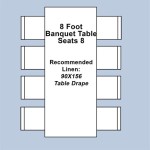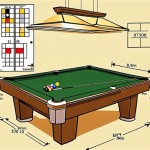66 Inch Round Dining Table: Seating Capacity and Considerations
A 66-inch round dining table represents a substantial piece of furniture, often serving as a focal point in a dining room or large kitchen. Determining the appropriate seating capacity for such a table is crucial for comfortable and functional dining experiences. The number of people that can comfortably sit at a 66-inch round table depends on several factors, including chair width, personal space preferences, and the table's base design.
The primary determination of seating capacity revolves around the individual space allowed per diner. A common guideline suggests allocating approximately 24 inches of perimeter space per person. This measurement provides adequate elbow room and prevents diners from feeling cramped. However, this is a general estimation and can vary based on individual needs and preferences.
Using this 24-inch guideline, one can calculate the total perimeter of a 66-inch round table. To find the perimeter (circumference), the formula is C = πd, where C represents the circumference, π (pi) is approximately 3.14159, and d is the diameter of the circle. In this case, the diameter is 66 inches. Therefore, the circumference is approximately 3.14159 * 66 inches, resulting in a perimeter of roughly 207.35 inches.
Dividing the total perimeter by the 24-inch guideline (207.35 inches / 24 inches per person) yields approximately 8.64. This suggests that a 66-inch round table could theoretically accommodate around 8 to 9 individuals. However, this number should be considered an upper limit, especially when aiming for a more relaxed and spacious dining arrangement. The actual comfortable seating capacity often falls between 6 and 8 people.
Beyond the simple perimeter calculation, several other considerations influence the ideal number of seats for a 66-inch round dining table. These factors relate to the comfort and functionality of the dining experience, as well as the overall aesthetics of the room.
Chair Dimensions and Style
The dimensions of the chairs significantly impact how many people can comfortably fit around the table. Chairs with wider armrests or larger overall frames require more space than narrower, armless chairs. When selecting chairs, it's essential to measure their width and consider the clearance needed between each chair for ease of movement. A general recommendation is to allow at least 6 inches of space between chairs. This ensures that diners can comfortably sit and stand without bumping into each other.
The style of the chair also matters. Chairs with outward-sloping legs can take up more space than those with straight legs. Similarly, chairs with high backs may create a more visually crowded appearance, influencing the perception of available space. Selecting chairs that complement the table's style and size is essential for creating a cohesive and comfortable dining area.
Consider the placement of the chair legs in relation to the table edge. If the chair legs extend significantly beyond the seat, they can impede legroom for other diners, particularly if those diners are seated between the legs. Opting for chairs with a narrower footprint can maximize seating capacity without sacrificing comfort.
Table Base Design and Leg Placement
The design of the table base plays a critical role in determining how many people can comfortably sit at the table. A pedestal base, for example, typically allows for more legroom and flexibility in seating arrangements since there are no legs obstructing the perimeter. This type of base is often preferred for round tables as it promotes a more inclusive and communal dining experience.
Tables with four legs, particularly those positioned close to the edge of the table, can significantly restrict legroom and reduce the number of people who can comfortably sit around the table. If a table with four legs is chosen, it's crucial to ensure that the legs are positioned far enough inward to allow ample space for diners to stretch their legs without bumping into them. This is especially important for taller individuals.
The thickness and design of the table's apron (the decorative trim underneath the tabletop) also contribute to legroom. A thick apron or one that extends too far downward can make it difficult for some individuals to sit comfortably, particularly if they have longer legs. Opting for a table with a thinner apron or one that is positioned higher can alleviate this issue.
Personal Space Preferences and Dining Style
Different individuals have varying preferences regarding personal space. Some people prefer to sit closer together, while others require more room to feel comfortable. When determining the ideal seating capacity, it's important to consider the typical dining style and the preferences of the individuals who will be using the table regularly. For formal dining occasions, a more spacious arrangement might be preferred, whereas for casual family meals, a slightly tighter arrangement may be acceptable.
The nature of the meals served also influences seating needs. For example, if serving dishes that require a lot of table space (such as large platters or multiple serving bowls), providing more room per person is advisable. This allows diners to comfortably access and serve themselves without feeling cramped. Conversely, if most meals consist of individually plated dishes, a slightly tighter seating arrangement might be acceptable.
Consider the age and physical abilities of the users. Elderly individuals or those with mobility limitations may require more space to sit and stand comfortably. Similarly, children may need a slightly wider space to avoid accidental bumping or jostling. Adapting the seating arrangements to accommodate the needs of all users ensures a more pleasant and inclusive dining experience.
Beyond the physical considerations, the overall ambiance and desired dining experience should be taken into account. A more formal dining room might benefit from a slightly more spacious arrangement, creating a sense of elegance and refinement. A more casual dining area might comfortably accommodate a slightly higher seating capacity, fostering a more convivial and intimate atmosphere.
Ultimately, determining the ideal seating capacity for a 66-inch round dining table is a balancing act between maximizing space utilization and prioritizing comfort. By carefully considering chair dimensions, table base design, and personal space preferences, one can create a dining area that is both functional and aesthetically pleasing. While the 24-inch guideline provides a useful starting point, it's essential to adapt the seating arrangements to suit individual needs and the specific context of the dining space.
It is recommended to physically test the seating arrangement with the chosen chairs to ensure adequate space and comfort before making a final decision. This hands-on approach allows for fine-tuning and ensures that the table comfortably accommodates the intended number of diners.

Professional Table Seating Guide The Chiavari Chair Company Is Now Chivari

Round Table Seating Guide Diy Kitchen Dining Room

Maison Dining Table 66 Round Nüage Designs

Round Dining Table Dimensions

How To Calculate The Best Dining Table Size For Your Room

Round Custom Made Solid Wood Dining Conference Tables

How To Calculate The Best Dining Table Size For Your Room

Round Custom Made Solid Wood Dining Conference Tables

66 Round Extension Dining Table With Center Pedestal Opening To 12 C 1880 For At 1stdibs Inch Tables Seats How Many

A Rudin 66 Round Expandable Dining Table Chairish








